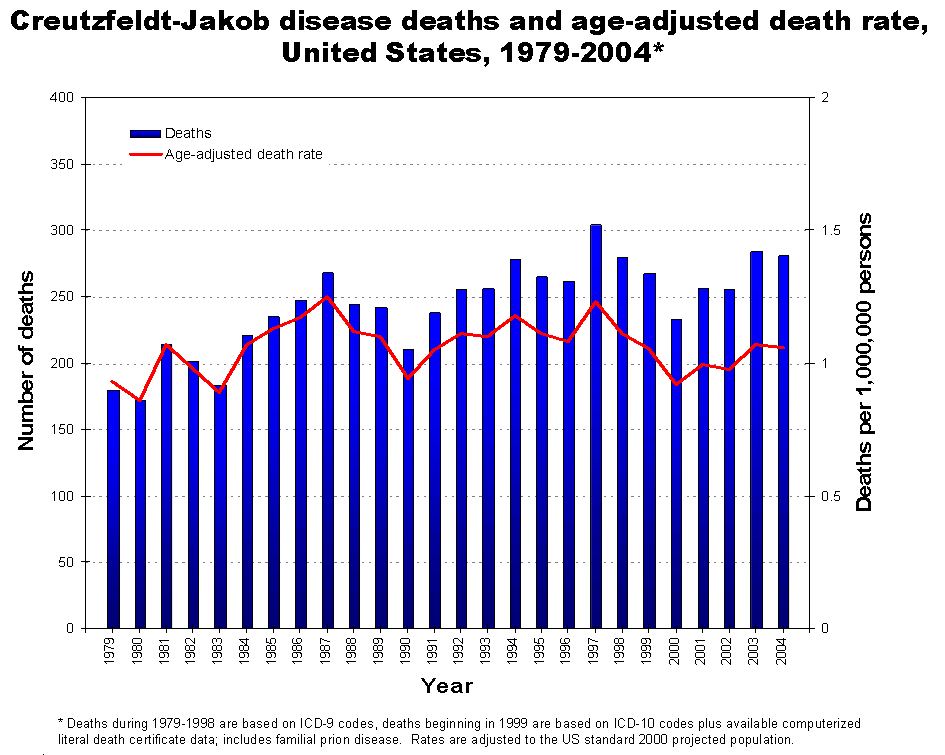Creutzfeldt-Jakob disease epidemiology and demographics: Difference between revisions
No edit summary |
No edit summary |
||
| (6 intermediate revisions by 3 users not shown) | |||
| Line 1: | Line 1: | ||
__NOTOC__ | __NOTOC__ | ||
{{Creutzfeldt-Jakob disease}} | {{Creutzfeldt-Jakob disease}} | ||
{{CMG}} | {{CMG}}{{AE}}{{MMJ}} | ||
==Overview== | ==Overview== | ||
Creutzfeldt Jakob disease is a | Creutzfeldt-Jakob disease is a rare disorder with an incidence of approximately 0.1 to 0.3 cases per 100,000 individuals. In the USA, less than 300 cases of Creutzfeldt-Jakob disease have been reported. Individuals > 50 years of age are at higher risk of developing Creutzfeldt-Jakob disease than younger individuals. The most common age at diagnosis is approximately 60-65 years (range 45-90). On the other hand, [[Variant Creutzfeldt-Jakob disease|variant (non-classic) Creutzfeldt-Jakob disease]] is more common among younger individuals. There is no gender or racial predilection for the development of Creutzfeldt-Jakob disease. Creutzfeldt-Jakob disease is more commonly described in Africa, but this is thought to be attributed to cannibalism practices in certain African tribes in the 1950s and ingestion of infected [[human]] brains, rather than true racial variation. | ||
==Epidemiology and Demographics== | ==Epidemiology and Demographics== | ||
===Incidence=== | |||
*Creutzfeldt Jakob disease is a very rare disorder | |||
*The incidence of Creutzfeldt Jakob disease is approximately 0.1 to 0.3 cases per 100,000 individuals. | |||
*In the USA, less than 300 cases of Creutzfeldt Jakob disease have been reported. | |||
[[Image:Figure annual deaths 2004.png|600px|CJD deaths and age-adjusted death rate, USA, 1979-2004]] | |||
===Age=== | |||
*Individuals > 50 years of age are at higher risk of developing Creutzfeldt Jakob disease than younger individuals. | |||
*The most common age at diagnosis is approximately 60-65 years (range 45-90). | |||
*On the other hand, [[Variant Creutzfeldt-Jakob disease|variant (non-classic) Creutzfeldt-Jakob disease]] is more common among younger individuals. | |||
=== | ===Gender=== | ||
*There is no gender predilection for the development of Creutzfeldt Jakob disease. | |||
* | |||
===Race=== | |||
*There is no racial predilection for the development of Creutzfeldt Jakob disease. | |||
*Creutzfeldt Jakob disease is more commonly described in Africa, but this is thought to be attributed to cannibalism practices in certain African tribes in the 1950s and ingestion of infected human brains, rather than true racial variation. | |||
==References== | ==References== | ||
| Line 39: | Line 31: | ||
{{WikiDoc Sources}} | {{WikiDoc Sources}} | ||
[[Category:Neurology]] | [[Category:Neurology]] | ||
[[Category:Disease]] | [[Category:Disease]] | ||
[[Category:Transmissible spongiform encephalopathies]] | [[Category:Transmissible spongiform encephalopathies]] | ||
Latest revision as of 16:13, 20 November 2018
|
Creutzfeldt-Jakob disease Microchapters |
|
Differentiating Creutzfeldt-Jakob disease from other Diseases |
|---|
|
Diagnosis |
|
Treatment |
|
Case Studies |
|
Creutzfeldt-Jakob disease epidemiology and demographics On the Web |
|
American Roentgen Ray Society Images of Creutzfeldt-Jakob disease epidemiology and demographics |
|
FDA on Creutzfeldt-Jakob disease epidemiology and demographics |
|
CDC on Creutzfeldt-Jakob disease epidemiology and demographics |
|
Creutzfeldt-Jakob disease epidemiology and demographics in the news |
|
Blogs on Creutzfeldt-Jakob disease epidemiology and demographics |
|
Risk calculators and risk factors for Creutzfeldt-Jakob disease epidemiology and demographics |
Editor-In-Chief: C. Michael Gibson, M.S., M.D. [1]Associate Editor(s)-in-Chief: Mohamadmostafa Jahansouz M.D.[2]
Overview
Creutzfeldt-Jakob disease is a rare disorder with an incidence of approximately 0.1 to 0.3 cases per 100,000 individuals. In the USA, less than 300 cases of Creutzfeldt-Jakob disease have been reported. Individuals > 50 years of age are at higher risk of developing Creutzfeldt-Jakob disease than younger individuals. The most common age at diagnosis is approximately 60-65 years (range 45-90). On the other hand, variant (non-classic) Creutzfeldt-Jakob disease is more common among younger individuals. There is no gender or racial predilection for the development of Creutzfeldt-Jakob disease. Creutzfeldt-Jakob disease is more commonly described in Africa, but this is thought to be attributed to cannibalism practices in certain African tribes in the 1950s and ingestion of infected human brains, rather than true racial variation.
Epidemiology and Demographics
Incidence
- Creutzfeldt Jakob disease is a very rare disorder
- The incidence of Creutzfeldt Jakob disease is approximately 0.1 to 0.3 cases per 100,000 individuals.
- In the USA, less than 300 cases of Creutzfeldt Jakob disease have been reported.
Age
- Individuals > 50 years of age are at higher risk of developing Creutzfeldt Jakob disease than younger individuals.
- The most common age at diagnosis is approximately 60-65 years (range 45-90).
- On the other hand, variant (non-classic) Creutzfeldt-Jakob disease is more common among younger individuals.
Gender
- There is no gender predilection for the development of Creutzfeldt Jakob disease.
Race
- There is no racial predilection for the development of Creutzfeldt Jakob disease.
- Creutzfeldt Jakob disease is more commonly described in Africa, but this is thought to be attributed to cannibalism practices in certain African tribes in the 1950s and ingestion of infected human brains, rather than true racial variation.
